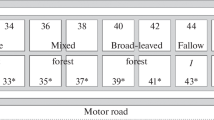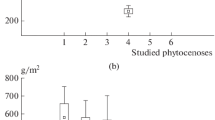Abstract
Time regularities of litter fall input are revealed in the investigation of phytocenoses under conditions of stationary soil lysimeters. These regularities correlate well with the dynamics typical of phytocenoses of the Botanical Garden of Moscow State University. The data on litter fall input obtained by sampling with the use of stationary litter fall traps and by the approach of collection of the total year litter fall are highly comparable. The total amount of organic substance and ash elements received with litter fall corresponds to the data given for natural ecosystems. It may be concluded that the functioning of modern phytocenoses under conditions of very restricted volume and area of soil lysimeters is normal.
Similar content being viewed by others
References
Bambalov, N.N., The lignin content in virgin and cultivated peat soils of Belarussian poles’e, Eurasian Soil Sci., 2007, vol. 40, no. 11, pp. 1175–1180.
Biryukov, M.V., Ryzhova, I.M., Gunina, A.A., et al., Stabilization of organic matter in soil lysimeters, Moscow Univ. Soil Sci. Bull., 2014, vol. 69, no. 2, pp. 55–61.
Blagoveshchenskii, Yu.N., Bogatyrev, L.G., Solomatova, E.A., and Samsonova, V.P., Spatial variation of the litter thickness in the forests of Karelia, Eurasian Soil Sci., 2006, vol. 39, no. 9, pp. 925–930.
Bogatyrev, L.G., Sventitskii, I.A., Sharafutdinov, R.N., and Stepanov, A.A., Forest litters and the diagnostics of the modern trend in humus formation in different geographical zones, Eurasian Soil Sci., 1998, vol. 31, no. 7, pp. 787–796.
Buyanovskii, G.A., The correlation between floral waste income and the number of soil microorganisms, Pochvovedenie, 1971, no. 6, pp. 130–136.
Vinnik, M.A. and Bolyshev, N.N., First observation results in open lysimeter, Pochvovedenie, 1972, no. 4, pp. 114–121.
Glazovskaya, M.A., Geokhimiya prirodnykh i tekhnogennykh landshaftov SSSR: Uchebnoe posobie dlya studentov geograficheskikh spetsial’nostei vuzov (Geochemistry of Natural and Anthropogenic USSR Landscapes: Student’s Book for Geography Specialization in Universities), Moscow, 1988.
Zolotarev, G.V., Nekotorye parametry biologicheskogo krugovorota v model’nykh eksperimentakh pochvennykh lizimetrov (Some Parameters of Biological Cycle in Model Experiments of Soil Lysimeter), Moscow, 2006.
Kovaleva, N.O. and Kovalev, I.V., Lignin phenols in soils as biomarkers of paleovegetation, Eurasian Soil Sci., 2015, vol. 48, no. 9, pp. 946–958.
Olovyannikova, I.N., Forest litters in the Siberian elm plantations with rook colonies, Eurasian Soil Sci., 2000, vol. 33, no. 11, pp. 1186–1192.
Razgulin, S.M., Mineralization of nitrogen compounds in the soil under the bilberry-sphagnum birch forest (Yaroslavl oblast), Eurasian Soil Sci., 2014, vol. 47, no. 2, pp. 70–77.
Remezov, N.P., Oak wood interaction with soil: research results, Tr. Voronezh. Gos. Zapoved., 1961, no. 13, pp. 9–53..
Rodin, L.E. and Bazilevich, N.I., Recommendations for analysis of biological cycle of ash substances and nitrogen in terrestrial plant communities in the main nature areas of the temperate zone, Bot. Zh., 1963, vol. 48, no. 6, pp. 869–877.
Samedov, P.A., Soil invertebrates’ role in plants wastes decomposition and humus formation of meadow sierozem soils, Pochvovedenie, 1988, no. 8, p.109.
Sapozhnikov, A.P., Forest litter: nomenclature, classification, and indexation, Pochvovedenie, 1984, no. 5, pp. 96–105.
Sakharov, M.I., Organic waste in forest phytocenosises, Pochvovedenie, 1939, no. 10, pp. 17–24.
Trofimov, S.Ya., Lazarev, A.S., and Fokin, A.D., Mineralization of organic-matter labile fragments in the humus-accumulative horizon of soddy-podzolic soil, Eurasian Soil Sci., 2012, vol. 45, no. 12, pp. 1110–1119.
Ushakova, G.I., Effect of ecological conditions on the rate and character of forest litter decomposition in the Kola Peninsula, Eurasian Soil Sci., 2000, vol. 33, no. 8, pp. 881–886.
Yaroslavtsev, A.M., Manucharova, N.A., Stepanov, A.L., et al., Microbial destruction of chitin in soils under different moisture conditions, Eurasian Soil Sci., 2009, vol. 42, no. 7, pp. 797–806.
Berg, B., Berg, M.P., and Bottner, P., Litter mass loss rates in pine forests of Europe and eastern United States: some relationships with climate and litter quality, Biogeochemistry, 1993, vol. 20, no. 3, pp. 127–159.
Bocock, K.L. and Gilbert, O.J.W., The disappearance of leaf litter under different woodland conditions, Plant Soil, 1957, vol. 9, no. 2, pp. 179–185.
Gustafson, F.G., Decomposition of the leaves of some forest trees under field conditions, Plant Physiol., 1943, vol. 18, no. 4, p.704.
Jansen, B., Hausmann, N.S., Tonneijck, F.H., et al., Characteristic straight-chain lipid ratios as a quick method to assess past forest-paramo transitions in the Ecuadoran Andes, Palaeogeogr., Palaeoclimatol., Palaeoecol., 2008, vol. 262, pp. 129–139.
Keuskamp, J.A., Dingemans, B.J.J., Lehtinen, T., et al., Tea Bag Index: a novel approach to collect uniform decomposition data across ecosystems, Methods Ecol. Evol., 2013, vol. 4, pp. 1070–1075.
Peters, K.E. and Moldowan, J.M., The Biomarker Guide, New York, 2005, 2nd ed.
Staaf, H., Foliage litter turnover and earthworm populations in three beech forests of contrasting soil and vegetation types, Oecologia, 1987, vol. 72, pp. 58–64.
Author information
Authors and Affiliations
Corresponding author
Additional information
Original Russian Text © Ph.I. Zemskov, V.S. Galkin, N.A. Anokhina, L.G. Bogatyrev, A.N. Demidova, N.G. Prilepsky, N.I. Zhilin, A.I. Benediktova, 2017, published in Vestnik Moskovskogo Universiteta, Seriya 17: Pochvovedenie, 2017, No. 1, pp. 9–15.
About this article
Cite this article
Zemskov, P.I., Galkin, V.S., Anokhina, N.A. et al. Methodical aspects of investigation of dynamic of litter fall input under conditions of stationary soil lysimeters. Moscow Univ. Soil Sci. Bull. 72, 7–12 (2017). https://doi.org/10.3103/S0147687417010082
Received:
Published:
Issue Date:
DOI: https://doi.org/10.3103/S0147687417010082




